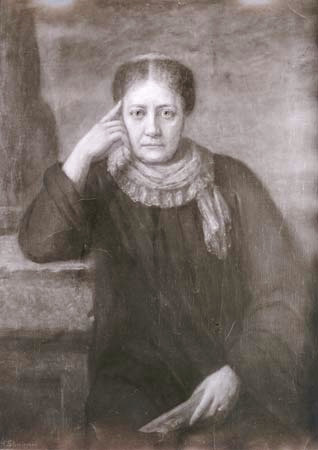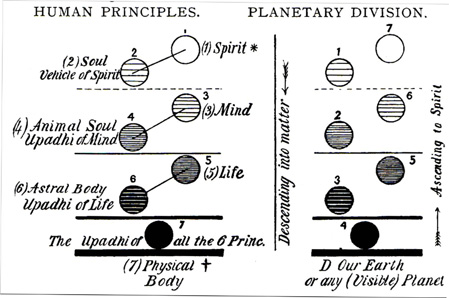|
|
|
|
|
|
BLAVATSKY, Helena Petrovna (1831 – 1891), Russian founder of theosophy had access in her youth to an extensive library belonging to her uncle, containing classical and hermetic texts. During her youth she read extensively in esoteric sources, and following a very brief, unsuccessful marriage at age 17 to Nicephore Blavatsky, she traveled widely in Canada, Texas, Mexico and India, attempting unsuccessfully to visit Tibet. In later life she claimed that at following at this period she spent seven years in an otherwise-unknown Tibetan monastery where she was intitated into a mysterious metaphysical brotherhood, with which she remained in clairvoyant contact for the rest of her life. Chief among the Tibetan “Masters” who would mystically commune with her later in life was Hoot Koomi, an apparently-transcendent entity whom she later claimed had the power to “precipitate" (teleport or materialize) letters and messages to her and her followers.“”
In 1858 she returned to Russia and acquired fame as a medium, claiming to be able to communicate with the dead. In 1870 she practiced as a medium in the United States where she became a naturalized citizen and continued her occult and kabbalistic studies. She gradually abandoned traditional spiritualism, claiming instead to possess the ability to communicate with her Tibetan “Mahatmas” in their remote monastery by means of their projected astral bodies. In New York in 1875 she founded the Theosophical Society together with her supporter, Colonel Henry S. Olcott for the stated purpose of:
1. forming a universal brotherhood of man,
2. studying and making known the ancient religions, philosophies and sciences (to which she and her transcendent Masters would provide the interpretive key)
3. investigating the laws of nature and developing the divine powers latent in man.
She expressed her teaching in a mixture of Hindu and Buddhist terminology, combining Egyptian, kabbalistic, occult, and modern spiritualistic concepts largely drawn from contemporary esoteric authors. Modern studies of her writings have demonstrated extensive plagiarism from both ancient and contemporary sources, including the writings of Eliphas Levi, Mackenzie’s Royal Masonic Encyclopaedia, and esoteric reinterpretations of Plato and hermetic and gnostic texts. She compiled for her disciples A Glossary of Theosophical Terms (1890 – 1892). Her principal works were Isis Unveiled (New York, 1877), The Secret Doctrine, the Synthesis of Science, Religion and Philosophy (1888), and The Key to Theosophy (1891).
Controversies in England concerning spiritualism may have played a role in her decision to move to India, where she converted to Buddhism, preached theosophy, and again practiced spiritualism. Accusations and a trial for fraud compelled her return to England (she was convicted of fraud in absentia), where she died in 1891 in the home of her disciple and successor Annie Besant. Her last work was The Secret Doctrine, portions of which which she claimed to have translated from the otherwise-unknown Book of Dzyan, a text of “secret teaching from the archaic ages” written in an otherwise-unknown language.
The following is typical of her asertions in Isis Unveiled:
The lotus is the product of fire (heat) and water, hence the dual symbol of spirit and matter. The God Brahma is the second person of the Trinity, as are Jehovah (Adam-Kadmon) and Osiris, or rather Pimander, or the Power of the Thought Divine, of Hermes; for it is Pimander who represents the root of all the Egyptian Sun-gods. The Eternal is the Spirit of Fire, which stirs up and fructifies and develops into a concrete form everything that is born of water or the primordial earth, evolved out of Brahma; but the universe is itself Brahma, and he is the universe. This is the philosophy of Spinoza, which he derived from that of Pythagoras; and it is the same for which Bruno died a martyr. How much Christian theology has gone astray from its point of departure, is demonstrated in this historical fact. Bruno was slaughtered for the exegesis of a symbol that was adopted by the earliest Christians, and expounded by the apostles! The sprig of water-lilies of Bhodisat, and later of Gabriel, typifying fire and water, or the idea of creation and generation, is worked into the earliest dogma of the baptismal sacrament.
Isis Unveiled, Ch. 3
IN the Secret Doctrine she expands on her teachings in Isis Unveiled, describing both human metaphysical physiology and the cosmic planes that must be traversed after death. She offered an alternative to Darwinist theory, claiming that instead of evolving from lower forms, humanity had devolved from higher, transcendent beings whose state may be regained through esoteric study, meditation and practice.
 |
 |
| Helena Blavatsky | Anthropology and Cosmology, The Secret Doctrine |
This Webpage was created for a workshop held at Saint Andrew's Abbey, Valyermo, California in 2002